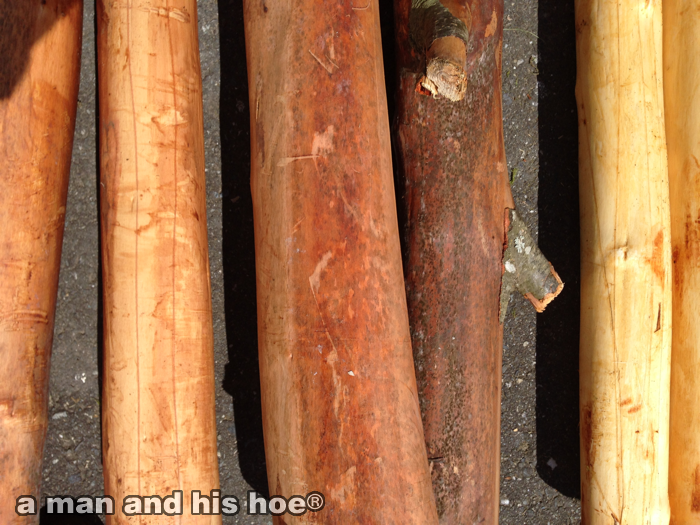Chicks will grow up without a mother hen to teach them how to feed. But when they do have one, they follow her around everywhere, watching what she is doing, what she eating, how she is digging it up, and finding out what she finds especially delicious.
[wpvideo QbqTWTwC]
Author: theMan
-
Teaching Them to Feed
-
Dandelions
Biking home from the post office this afternoon, I had to stop and take some photos of a field full of dandelions.







Look closely at each dandelion, and you quickly realize that it would take hours and hours for a person to make one flower. Each of the hundreds of seeds on a single flower has a fine stem. At the end of these stems are 30 to 40 fine threads attached which form the parachute the seeds use to fly away.
How long would it take to make one parachute and attach it to one seed? How long would it take to make the hundreds required for one flower? How about making the tens of thousands to decorate a single field?
And yet, no one has to lift a finger to make a field of dandelions so beautiful you just have to stop to take a look.
-
The Continuing Evolution of Genes
Carl Zimmer writes today in the New York Times in The Continuing Evolution of Genes that scientists used to believe that the some 20,000 genes we all have, came from our parents, which came from their parents, and on backwards to the very first forms of life. And that the genes all organisms have, can be traced back to these original genes.
The thinking was that at first there were just a few genes, and at times when they duplicated, making two copies of the same genes, which over time evolved into different genes, hence the increasing number and complexity of genes we now find.
With new genes evolving from earlier ones, it would be possible to compare the genes and see which genes came from which genes.
But when scientists gained the ability to read DNA sequences, they discovered that though most genes were duplicated versions of earlier ones, there were also a number of genes which were unique to a species. They called these orphan genes de novo genes. Unlike most genes which have been passed down through the generations for billions of years, de novo genes came into being much later.
Carl Zimmer’s article explains how these orphan genes came into existence, and the role they play in evolution. The article is worth a read. It also has a podcast with a segment describing the origin of genes.
One thing I am trying to find is a scientist who is researching how instinct is encoded in DNA. The first time one of my hens hatched and raised a clutch of chicks, it made me wonder how she knew how to that. She was a hatchery chick and raised without a mother. So how did she know that if she sat on an egg for 21 days that they would hatch. And all of the hens I’ve observed, use the same calls for danger, here’s good food, be quiet, etc. And all the chicks know from birth what these calls mean.
So how is all that complex behavior inscribed on DNA? I’ve come up with many scientists researching genetic behavior and trying to determine what behavior is genetic and what is learned. And scientists knocking out genes in organisms like flies to see how those genes affect fly behavior and the like. But I’ve yet to find the scientists looking at the GATC letters of specific DNA to tease out how complex behavior is carried by DNA from generation to generation. I’m sure it is extremely complicated, but hopefully there is a scientist out there who is studying this and can explain how nature does this amazing feat.
-
They Are All Unique
How do you tell them apart? When they are this young, like these eight chicks hatched yesterday, there is one that pops out because it is a different color. The rest look the same, but if you look closely, you’ll see little differences in the coloring, the feet, the faces, and the personalities. Some stay close to their mothers. Others are more adventurous. Some are quiet, others loud.
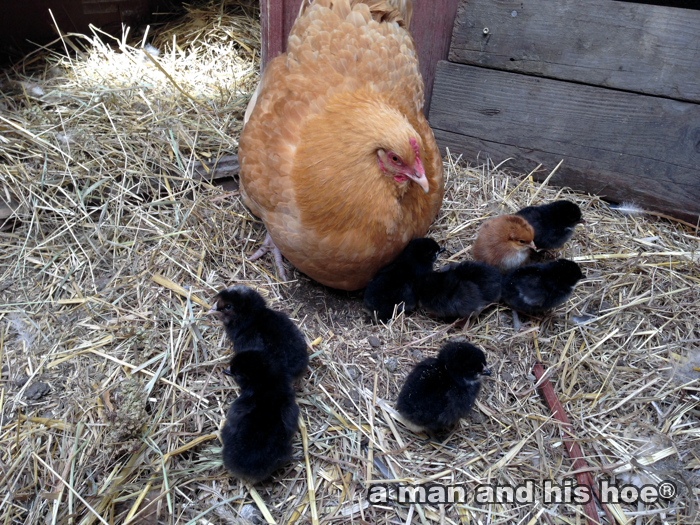
As they grow up, their differences shine. You would never mistake these two hens. Their coloring is very different, but so are their combs and wattles, their faces, and their beaks. Compare the combs on these two hens. One has floppy, rounded teeth on her comb. The other upright, pointed ones. There is an infinite variety of combs. Some flop left. Some flop right. Some both ways. Many are straight. Looking at their combs is one of the easiest ways to tell chickens apart.
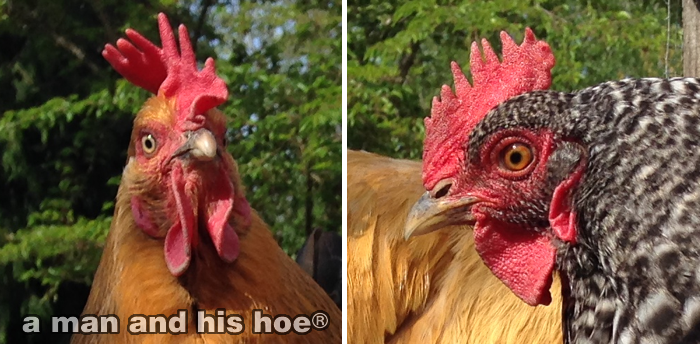
Their personalities also stand out. Stay in one place very long, and Billy and his consorts are sure to come by. You might say some roosters develop an entourage. To keep an entourage, they have to work at it. Hens won’t stick around if they aren’t being treated right.Of course, if you pack in chickens cheek to jowl, and only have hens, the dynamics change. In the wild, chickens never end up cheek to jowl. They spend as much time alone as they do with the rest of the flock. So it makes me think that chickens raised in the artificially super-packed quarters most are, must be under continuous stress, not know how to deal with having so many others around them all the time, and never having any time alone.
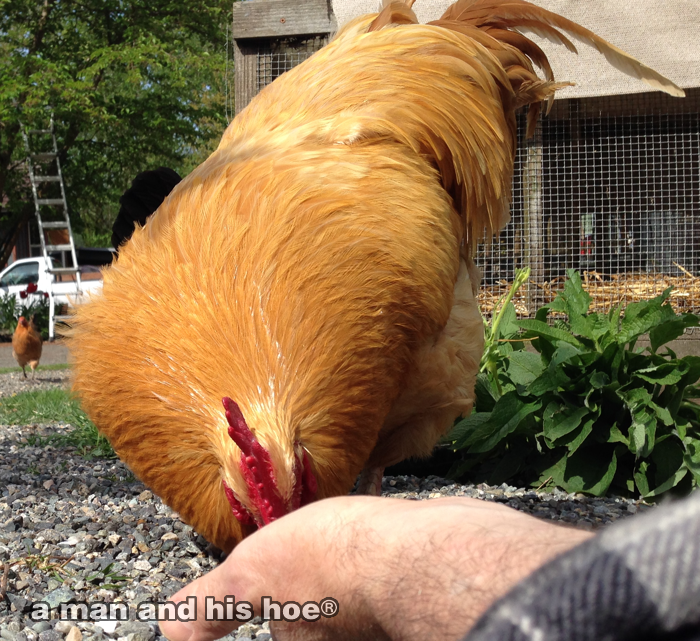
On a place like a man and his hoe®, chickens are not cackling all the time. But if you enter an egg laying house or poultry barn, the noise is deafening. They don’t make such continuous noise in a natural setting, so something is dreadfully wrong when they are packed in together. -
Places Chickens Love to Roam
Today is the type of day chickens dream about. The weather is nice, and there are plenty of good things to eat around the pond. On days like this, they wander far. It’s not unusual to find a hen, hidden in thick grass, a long distance from any of the other chickens.
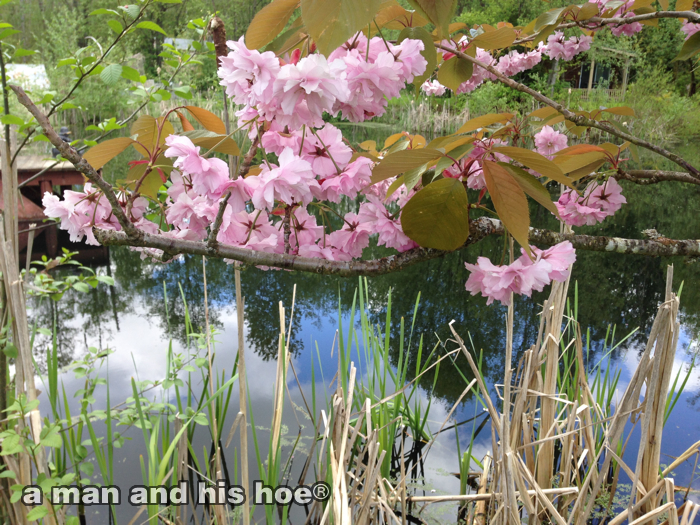
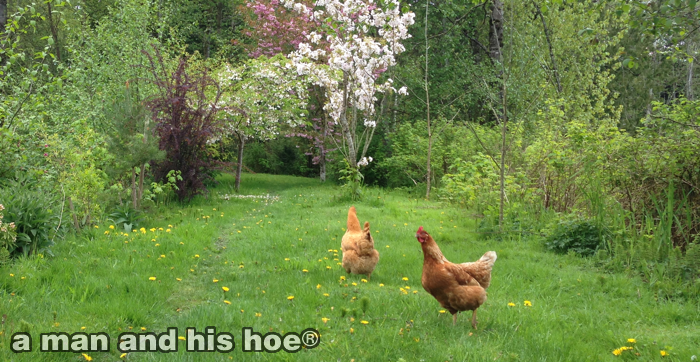
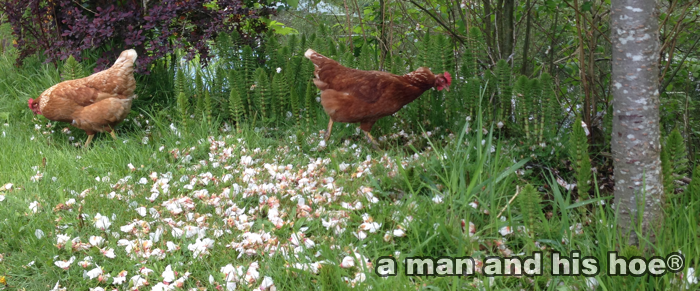
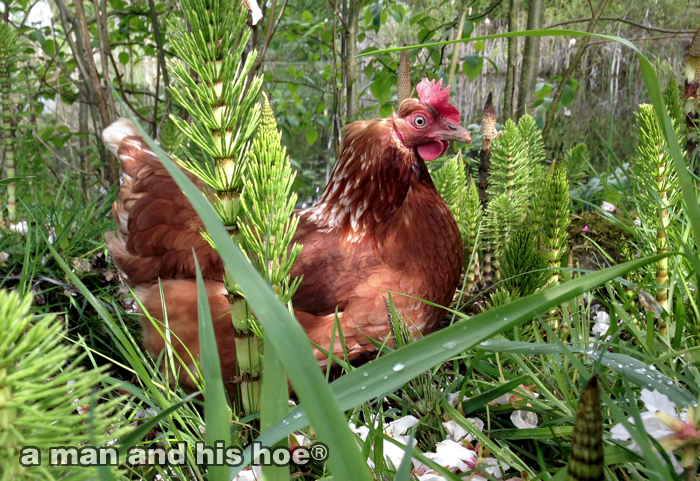
The first set of poles is done. The ones stripped last week are quite dark. Once the poles are up, they will make for a unique fence.
